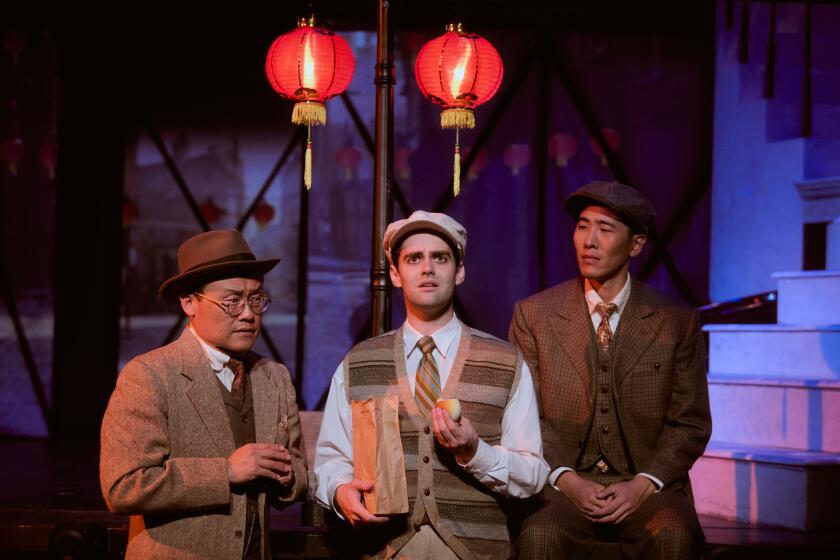Review: In ‘Villa + Discurso,’ pain is indelibly written into lives
How should we commemorate atrocity? And how can we move past it? These are the questions posed by “Villa + Discurso,” a double bill of spare, intense pieces by the highly regarded Chilean playwright and director Guillermo Calderón (“Neva,” “Diciembre”) appearing at REDCAT through Sunday in Spanish with English supertitles.
As Calderón explained on opening night, appearing unexpectedly on the half-lighted set before the show began, the plays were first performed at the Villa Grimaldi (outside Santiago, Chile), where about 5,000 people were held and tortured, and many disappeared, during the dictatorship of Augusto Pinochet (1973-1990). The building was demolished near the end of the regime, probably to erase evidence of human-rights violations, but the site remains a legacy of horror.
FULL COVERAGE: 2013 Spring arts preview
In “Villa,” three young women (Macarena Zamudio, Isabel Ruiz and Carla Romero), all mysteriously named Alejandra, have been tasked with deciding the site’s fate. Should the villa be reconstructed? Or should a museum be built in its place? But why? Short of actually torturing the visitors, there is no way to convey the suffering of the inmates. And art would just prettify the truth; or as one woman points out, “art does what art does.” Is it better to cause visitors pain or enjoyment -- or to let them forget?
Calderón’s stark lyricism and dreamlike imagery recall the magical realism of Nabokov (“Invitation to a Beheading”). At the same time he keeps stripping away his own metaphors, fighting against the lure of lyricism, and it becomes clear that the women’s struggle is also his own: how to write a play about the villa? Will a work of theater, however nobly intentioned, diminish the pain of the victims?
PHOTOS: Arts and culture in pictures by The Times
His direction, in line with this quandary, is fierce, meticulous and deft, but not at all eager to please. I admit that I found watching it more impressive than pleasurable. The three luminous, sympathetic actresses perform with impeccable discipline (bringing to mind hours of grueling rehearsal); every humorous moment Calderón permits them is followed by a rebuke. There is a sense that, if art is possible after monstrous crimes, it must be very stern art, indeed.
In the second piece, “Discurso,” the women share the role of Michelle Bachelet, the first woman president of Chile (2006-2010; she recently announced plans to run for re-election), who was herself tortured at the villa in her youth, as she delivers a (fictional) farewell speech. I couldn’t always tell whether Calderón’s portrait is affectionate or mocking, and after a while the fixed staging grew numbing. An intermission might have helped, but then we would have missed the unexpectedly intimate transition, in which one of the actresses sings Dan Fogelberg’s “Leader of the Band” as the others struggle to move a large collection of water glasses and then a heavy desk -- which come into play later, in an ominous finale. Calderón’s austere theatrical vision may not be crowd-pleasing, but it feels important.
ALSO:
One night with comedian Mark Maron ...
Playwright drags Chile’s conscience into the spotlight
Old Globe’s 2013-14 season to include extra helpings of the Bard
“Villa + Discurso.” REDCAT, 631 W. 2nd Street (Walt Disney Concert Hall complex), Los Angeles. 8:30 p.m. Friday and Saturday, 7 p.m. Sunday. $20 and $25. (213) 237-2800 or www.redcat.org. Running time: 2 hours, 10 minutes.
MORE
INTERACTIVE: Christopher Hawthorne’s On the Boulevards
CHEAT SHEET: Spring Arts Preview
PHOTOS: Arts and culture in pictures
More to Read
The biggest entertainment stories
Get our big stories about Hollywood, film, television, music, arts, culture and more right in your inbox as soon as they publish.
You may occasionally receive promotional content from the Los Angeles Times.
![LOS ANGELES, CA - JUNE 17: [Cody Ma and Misha Sesar share a few dishes from their Persian Restaurant Azizam] on Monday, June 17, 2024 in Los Angeles, CA. (Ethan Benavidez / For The Times)](https://ca-times.brightspotcdn.com/dims4/default/7ffc7f6/2147483647/strip/true/crop/5110x3417+306+0/resize/320x214!/quality/75/?url=https%3A%2F%2Fcalifornia-times-brightspot.s3.amazonaws.com%2F79%2Fdc%2F4d29255545f5b9813315901692bc%2F1459972-fo-azizam-review20-eba.JPG)





